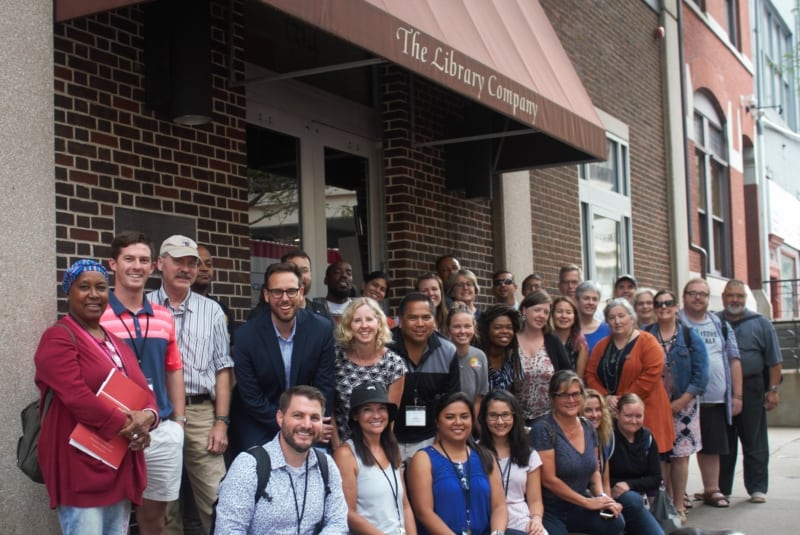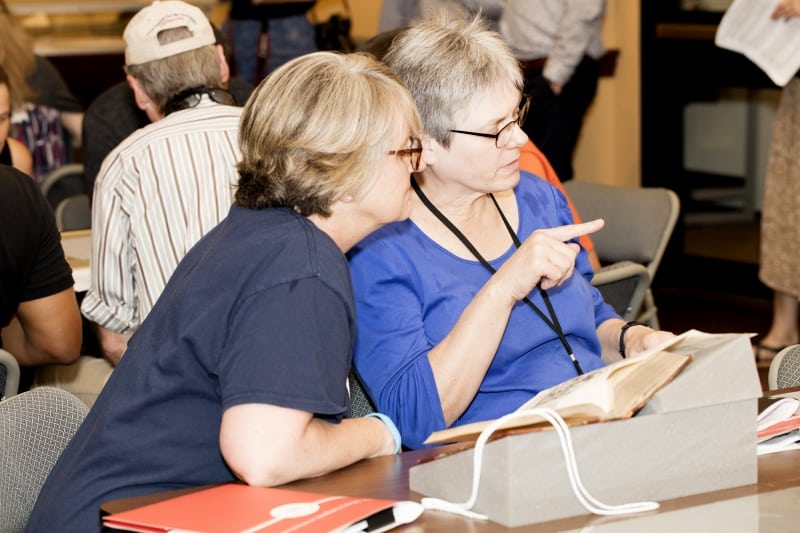Ghost River Goes to Summer School
The Teacher Seminar group in front of the Library Company
Earlier this month we completed the first major milestone of the Redrawing History: Indigenous Perspectives on Colonial America, a teacher seminar co-sponsored with the Gilder Lehrman Institute of American History.
“Native Peoples, Settlers, and European Empires in North America” wasn’t only a week-long institute for the teachers—a diverse group of 33 educators from across the country—but also an opportunity for our team to share Ghost River: The Fall and Rise of the Conestoga with practitioners, to benefit from their feedback, and to invite them to use the graphic novel in their classrooms this fall.
As an educational experience, this week-long institute was about as an intense as a semester-long graduate seminar. Our seminar leader, Daniel Richter, Director of the McNeil Center for Early American Studies, somehow managed to compress nearly 250 years of colonial history (1600-1840) into a sophisticated framework that considered settler colonialism as a multi-dimensional conflict between settlers, various native peoples, and numerous global empires vying for power. This seminar was impressive enough to attract the attention of C-SPAN, which recorded one of Dr. Richter’s lectures, and Education Week, which generously sent their curriculum reporter, Sarah Schwartz, to cover the seminar.
As humbling as Dr. Richter’s expertise was, the engagement educators brought much to conversations. At various times, the seminar felt like the greatest hits of graduate school, with participants raising questions, building upon one another’s ideas, and supporting each other as they developed lessons in relation to the content.
This brings me to my personal aspiration for the institute: that some of these brilliant educators would opt to write a lesson that we could integrate into Digital Paxton and even, possibly, the digital edition of Ghost River. Mind you, this was by no means a requirement. In fact, I wasn’t sure if faculty would have the chance to read the book as intended, with fully lettered pages (as opposed to script to be read in conjunction with images). Fortunately, one week before the seminar Lee Francis delivered the goods, submitting color pages with lettering, and, in some miraculous timing, Weshoyot Alvitre uploaded the final painted cover on the last day of the seminar. To say that fortune smiled on us would be an understatement.
But what if the educators just didn’t get it? This is a complicated story and one that requires significant context. Thankfully, I had a lot help. Our project team organized a collection review at the Library Company with presentations from the leadership at the Historical Society of Pennsylvania. Lee Francis flew out to Philadelphia to present twice—once for the teachers and once for the teachers and scholars at McNeil Summer Seminar. Perhaps most importantly, the faculty themselves invested in the project. They mastered the subtleties of Digital Paxton, asked questions that I couldn’t possibly answer, and presented thoughtful and innovative ways to integrate Ghost River into middle school and high school classrooms.
I’m delighted to report that more than one-third of the teachers opted to write lessons related to Ghost River. In fact, some of them crafted multi-lesson units. When Ghost River is published this fall, readers won’t only have access to the excellent lesson developed at the Gilder Lehrman Institute; they’ll be able to consult the digital edition for a dozen additional lessons developed for middle school, high school, English Language Learner (ELL), and AP students.
In fact, I’ve already published the first two lessons to Digital Paxton: Donna Sharer submitted “Listening for Voices: The Fall and Rise of the Conestoga,” a unit suitable for grades 6-11 and ELL students and Jenn Androsky’s “Neolin and Pontiac’s Rebellion” wrote for grade 9-12 AP US History. They’re both brilliant approaches to Ghost River that also supplement Digital Paxton as a teaching resource, and I just cannot wait to see them in the digital edition. Follow the Digital Paxton Facebook and Twitter feeds (@digitalpaxton) for additional materials. There are some incredible lessons in development.
Two Seminar participants look ove Library Company collections.
As we bask in the success of the 2019 Teachers Seminar, I wanted to close with a brief word of gratitude. First, this institute wouldn’t have been possible without the expertise of Daniel Richter and the leadership of our master teacher, Justin Emrich. I’m also indebted to both the Redrawing History project team—Raechel Hammer, Ann McShane, Clare Lowry, and Michael Barsanti—as well as various other staff at the Library Company and Historical Society of Pennsylvania, including Lee Arnold, Beth Twiss Houting, Jim Green, and Sophia Dahab. Finally, I want to recognize all of the teachers who made this institute so rewarding:
Maria Adamson
Jenn Androsky
Robert Barnes
Lindsay Bowman
Chelsea Branch
Lauren Buck
LeAnn Cassidy
Paul Clementi
Amanda Cooper
Jacqueline Dukes
Sandra Garner
Peter Gaynor
Cynthia Geesey
Eric Gutierrez
Victorious Hall
Ernestine Heldring
Jacqueline Katz
Maria Adamson
Jenn Androsky
Robert Barnes
Lindsay Bowman
Chelsea Branch
Lauren Buck
LeAnn Cassidy
Paul Clementi
Amanda Cooper
Jacqueline Dukes
Sandra Garner
Peter Gaynor
Cynthia Geesey
Eric Gutierrez
Victorious Hall
Ernestine Heldring
Jacqueline Katz
You folks are an inspiration, and I hope you’ll come back to the Library Company very soon.
Redrawing History: Indigenous Perspectives on Colonial America has been supported by The Pew Center for Arts & Heritage.





![Illustration [or Illustrations] from an article on Boffin’s Bower, Frank Leslie’s Illustrated Newspaper 26 June, 1875.](https://librarycompany.org/wp-content/uploads/2lper-1575-f-v40-1875-p257-80x80.jpg)